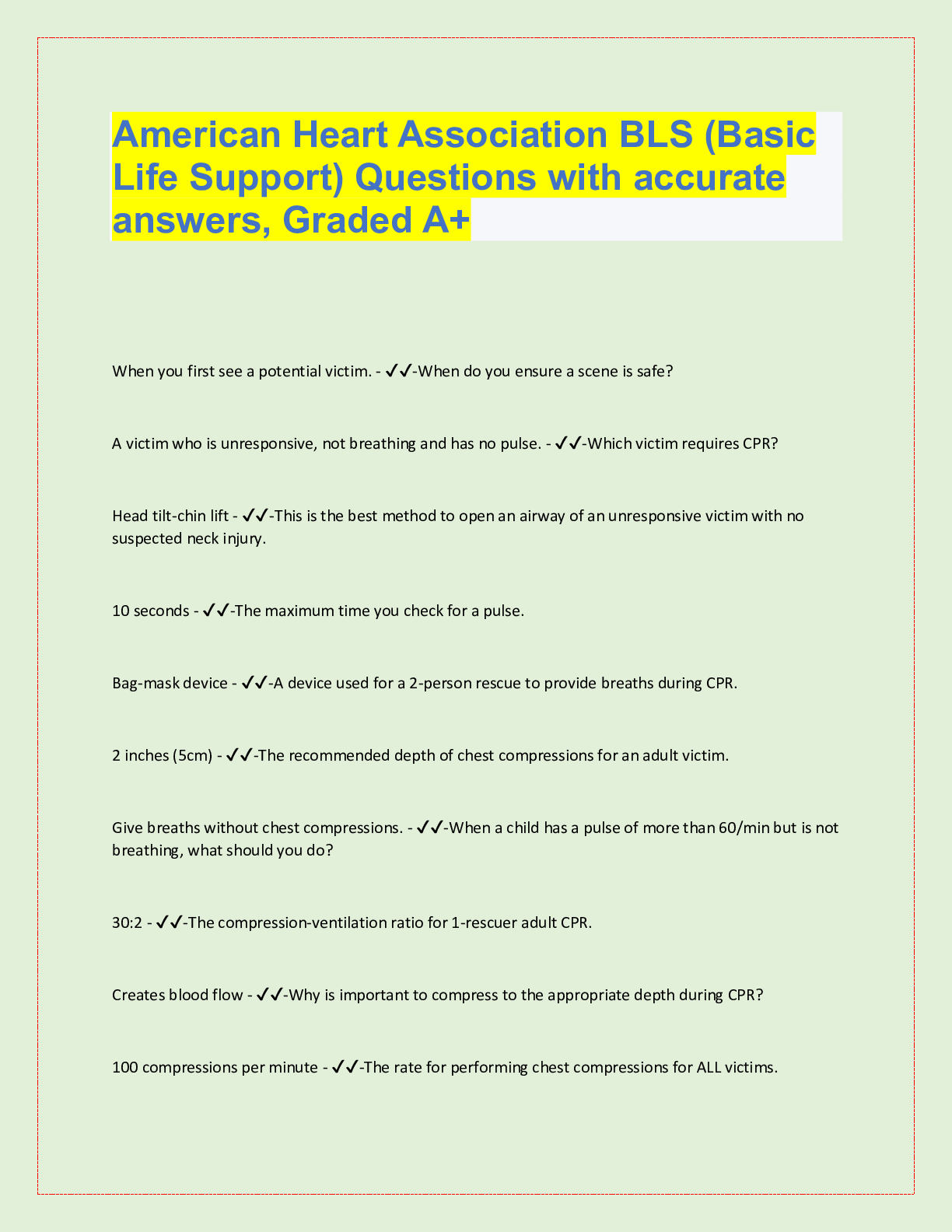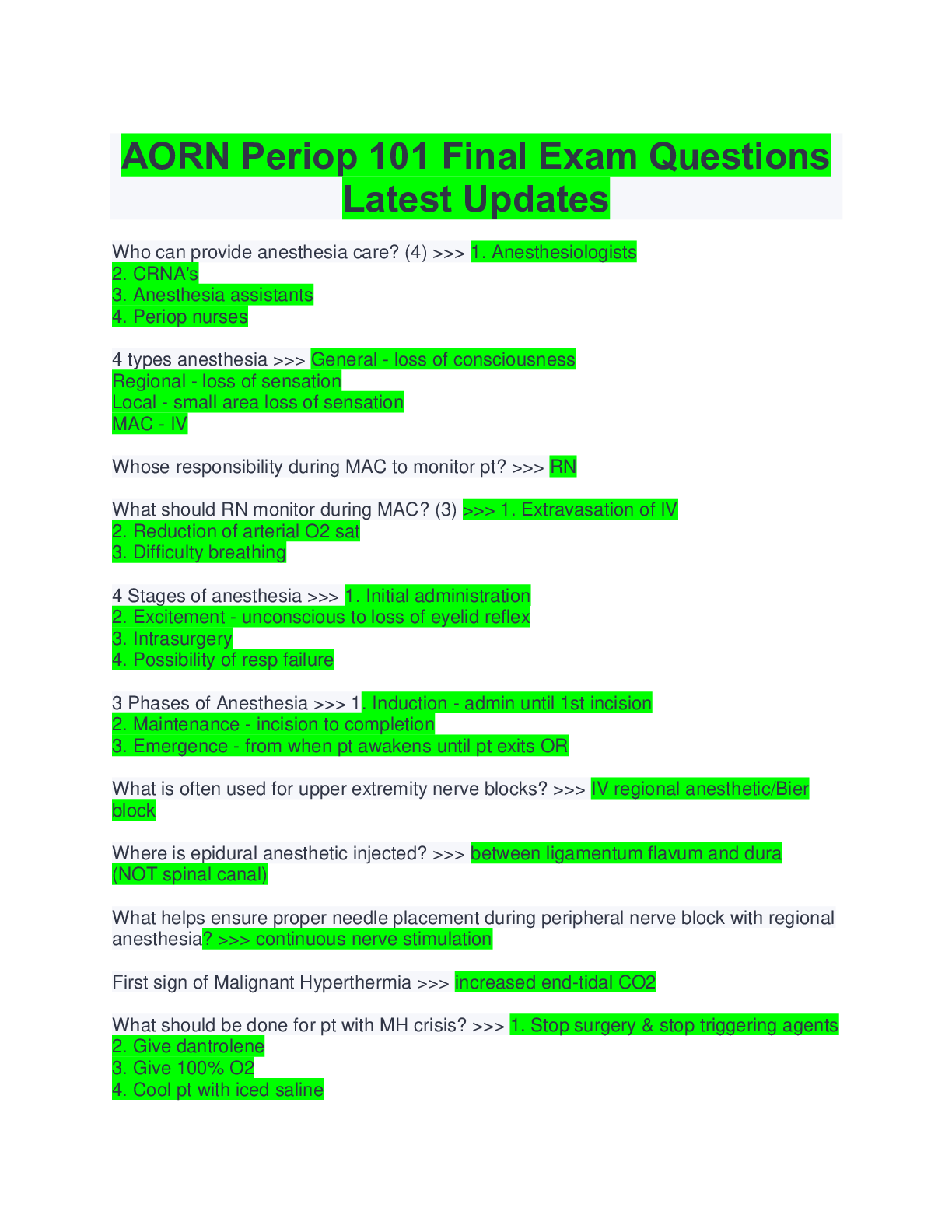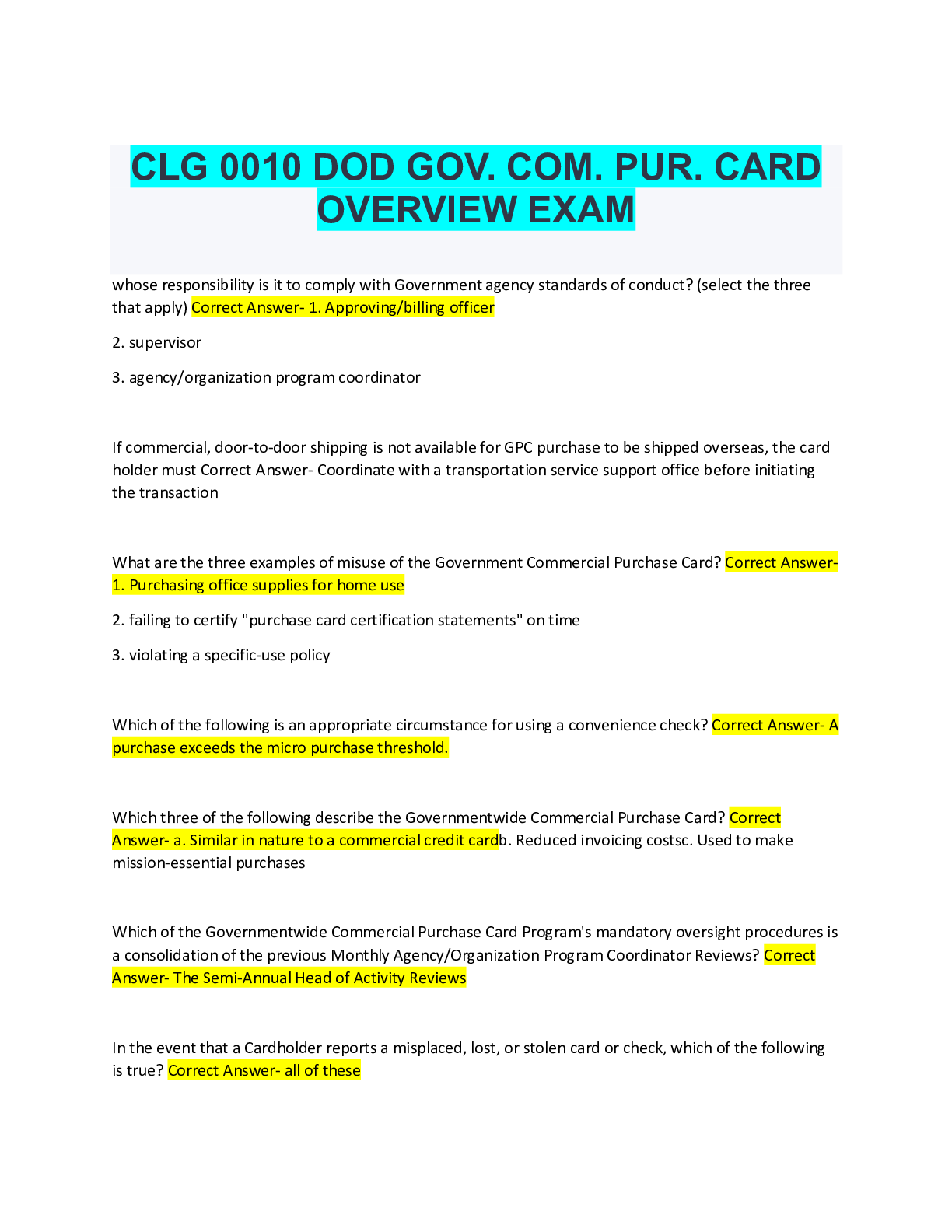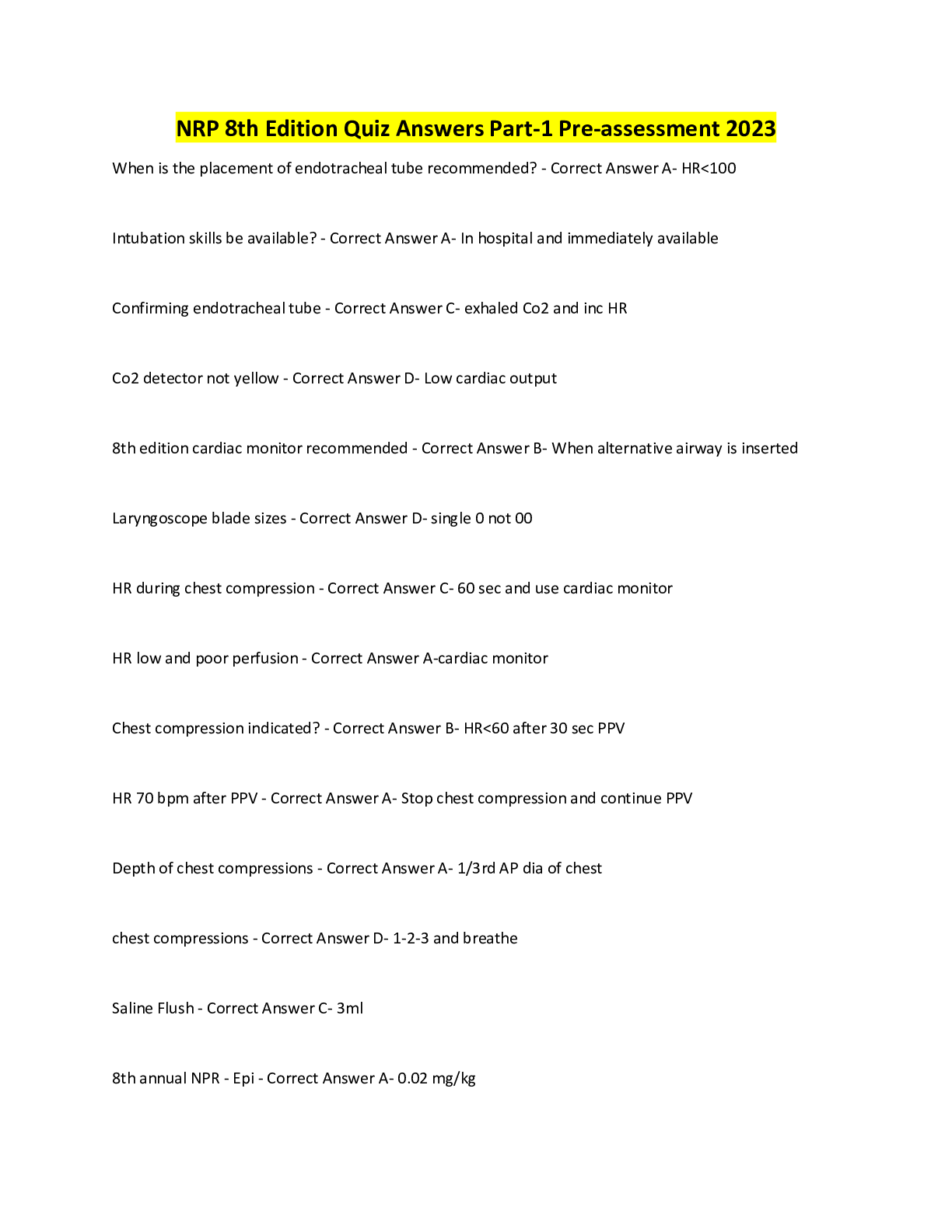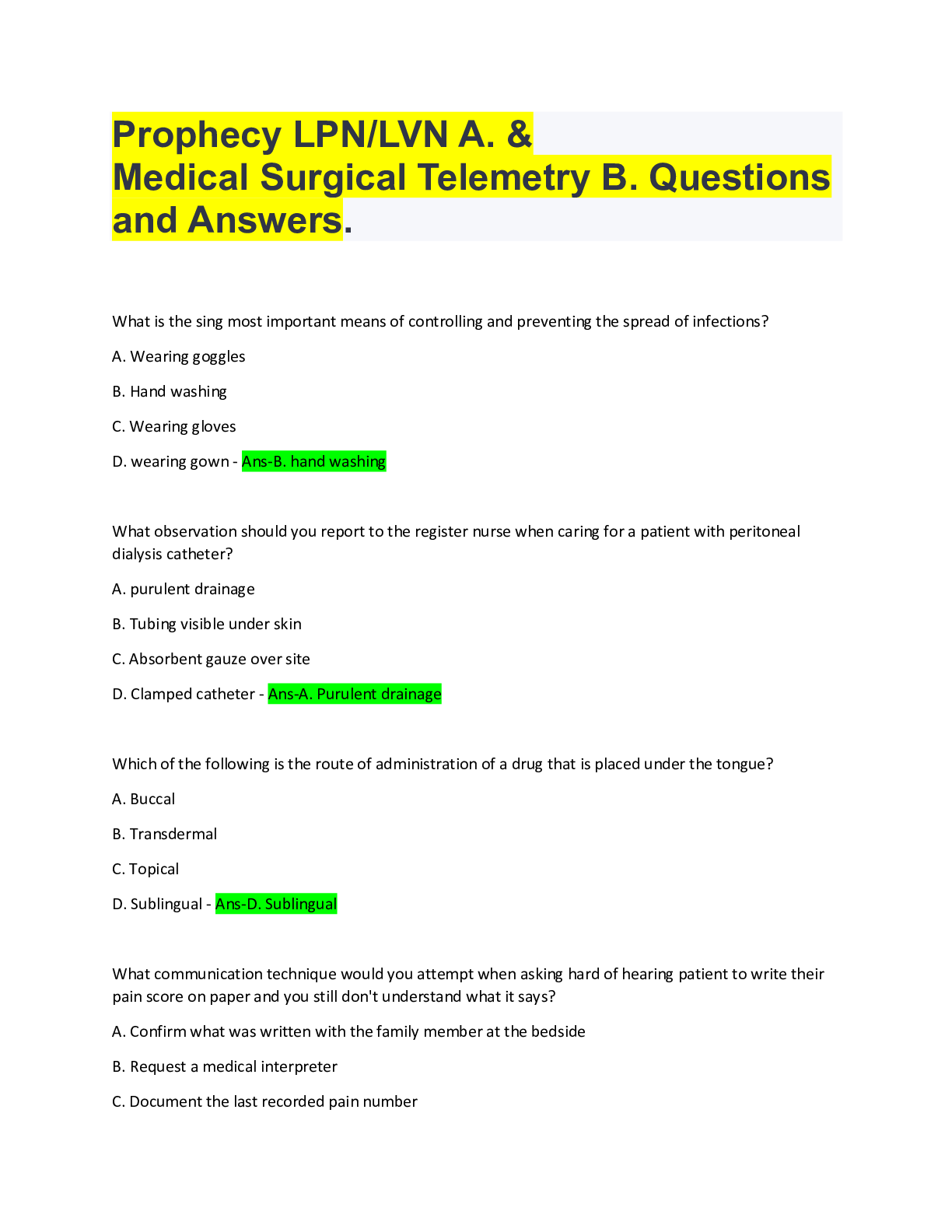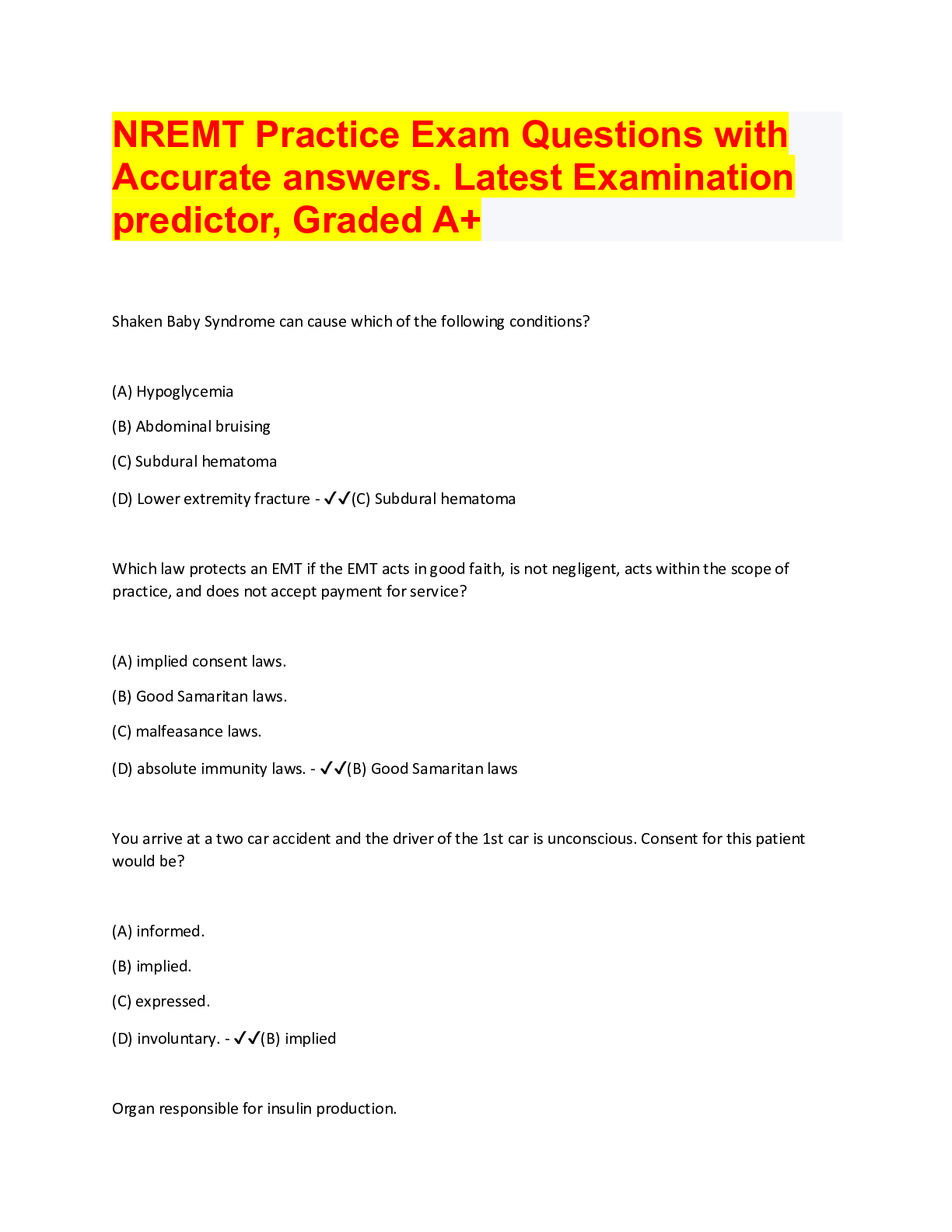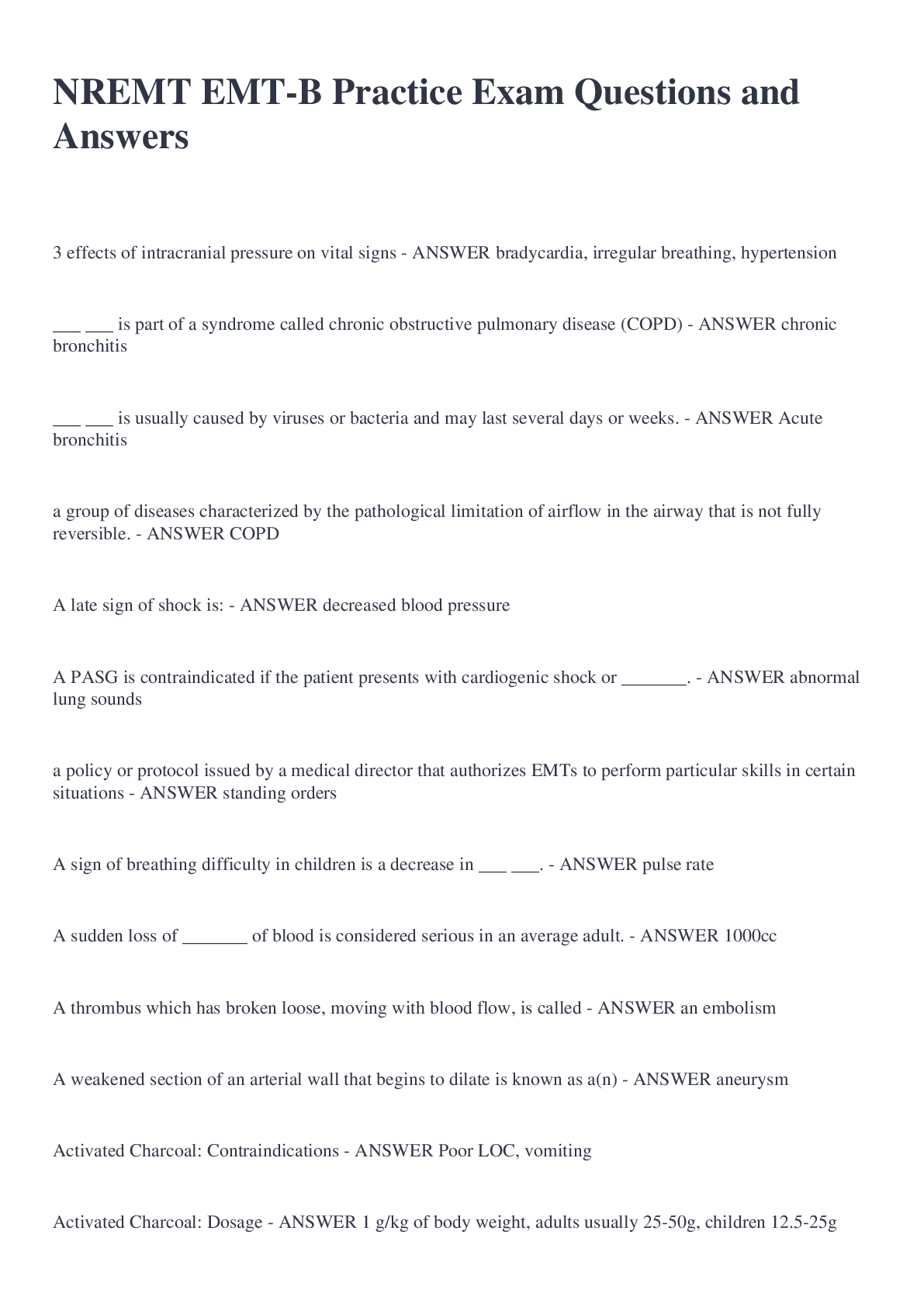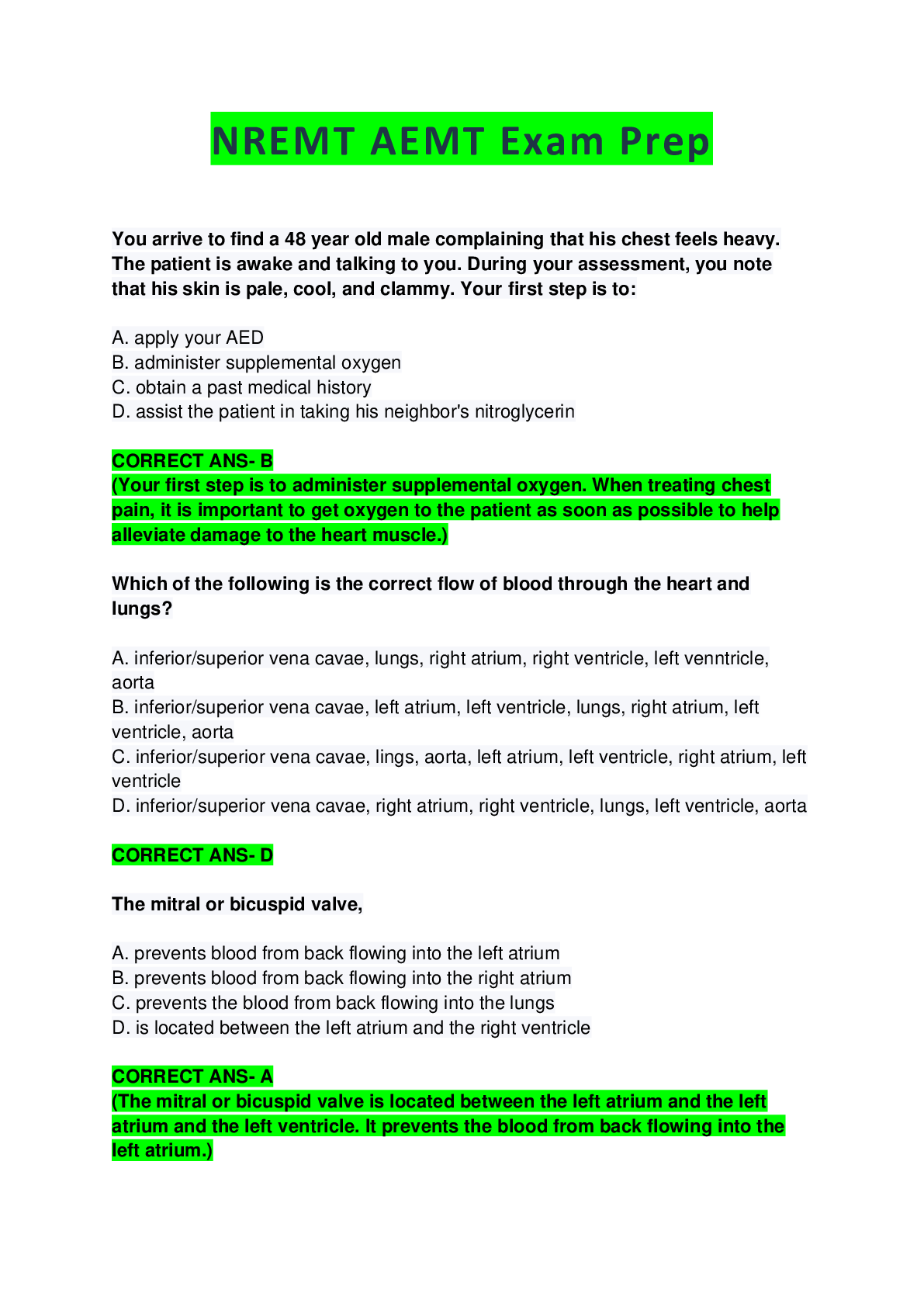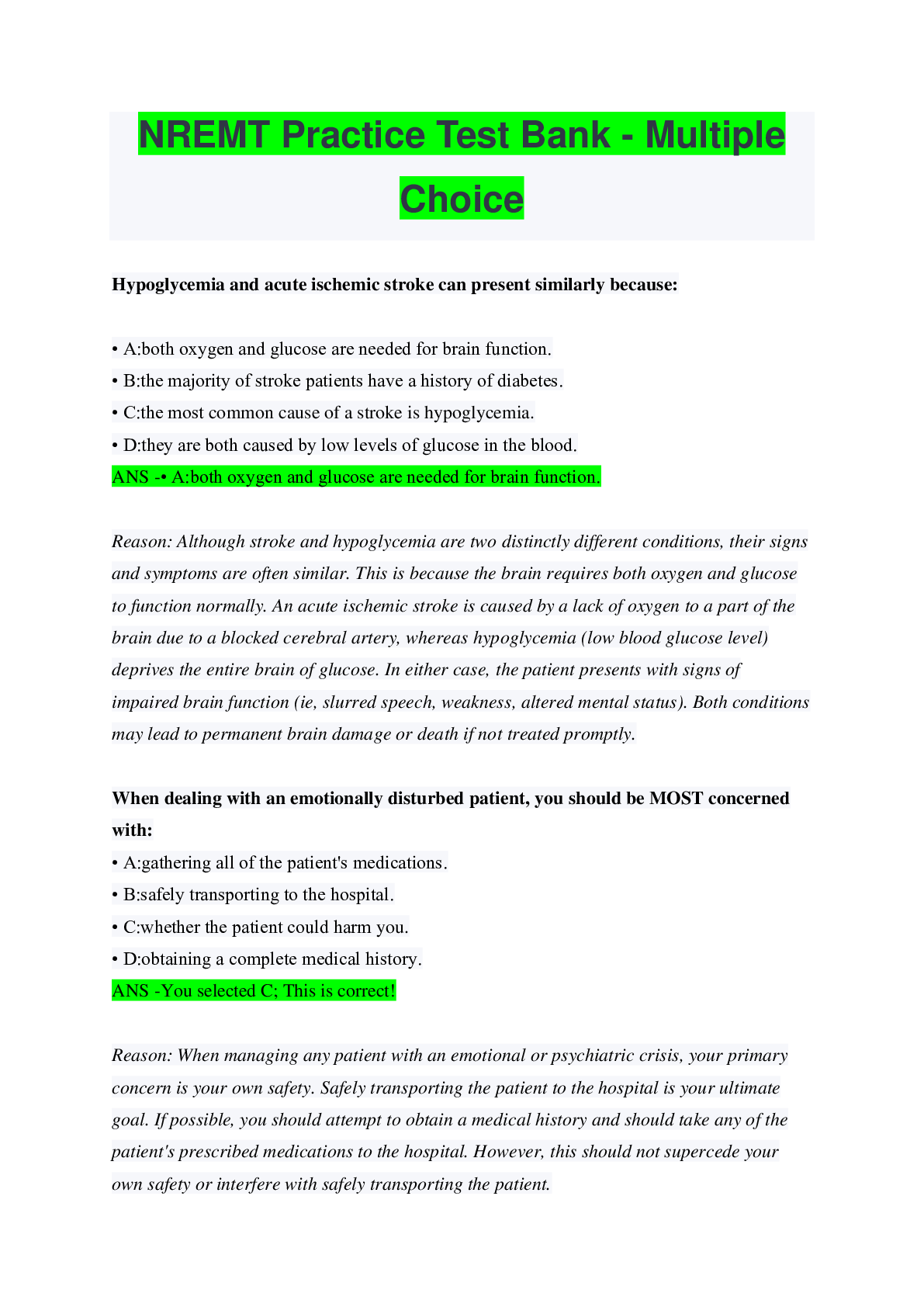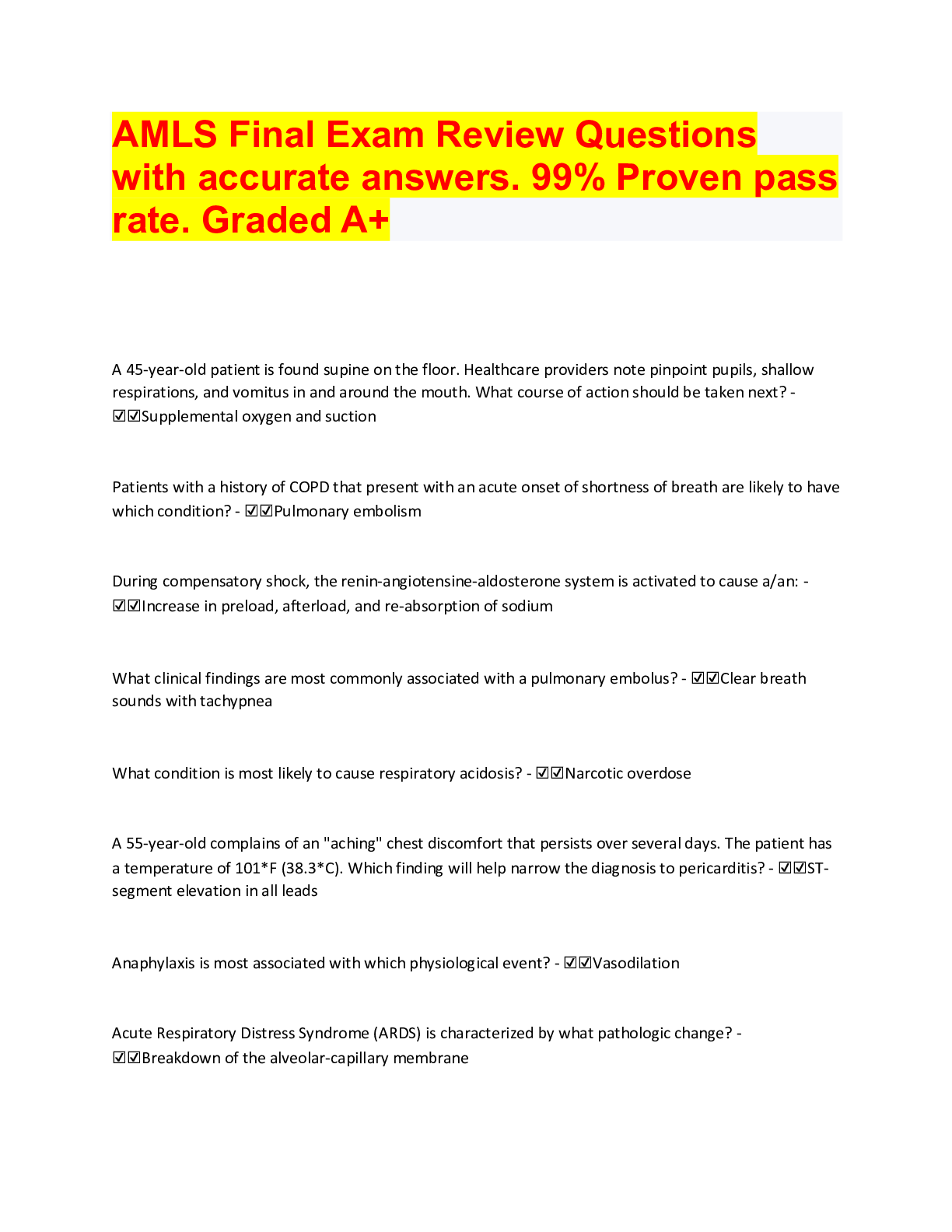*NURSING > QUESTIONS & ANSWERS > ASWB PRACTICE EXAM 2021/2022. All questions with accurate answers and rationale. Graded A+ (All)
ASWB PRACTICE EXAM 2021/2022. All questions with accurate answers and rationale. Graded A+
Document Content and Description Below
A social worker is working with a young child who is a victim of sexual abuse. The social worker has been using play therapy techniques for several sessions, but the child is becoming more aggressive ... and continue to exhibit disturbing behaviors such as bed-wetting and masturbation. The child's foster parents feel that the child is not making progress in therapy and have asked the foster care worker to assign a new social worker. What should the social worker do FIRST? A. Tell the foster care worker that the child is making progress as quickly as can be expected B. Transfer the child to someone who specialized in child cognitive-behavioral therapy. C. Encourage the child to talk freely about feelings and the details of the sexual abuse. D. Educate the foster parents about the effects of child sexual abuse. - ✔✔Rationale: The social worker should FIRST help the foster parents understand the long-term impacts of childhood sexual abuse and the unpredictable treatment progress (D). Option (A) does not provide enough meaningful information to the foster care worker. There is no need to transfer the child (B) because play therapy is indicated for this age group. Encourage a young child to talk to about the abuse (C) is often counterproductive and contraindicated. A social worker meets with a 75-year old client whose wife died six months ago. In the Intake interview, the client reports losing weight, having very little energy, and having difficulty getting motivated to do things. What should the social worker do FIRST? A. Complete a suicide risk assessment of the client. B. Explore available family and community resources C. Suggest that the client schedule an appointment with a doctor. D. Refer the client to a local bereavement group. - ✔✔Rationale: The client's self-report describes depression and suicide risk that warrant further assessment (Key A). Option (B), (C), and (D) are all plausible but not the FIRST action the social worker should take. A social worker meets with a 35-year-old American man who is anxious because his wife is pressuring him to move his mother into a nursing home. He prefers that she live with them. The social worker asks the man if he has any siblings and what his birth order is. This information is important to the social worker's understanding of the man's: A. cultural perspective B. support system C. financial options D. family dynamics - ✔✔Rationale: It is always important for a social worker to understand the cultural context of client situations. Information about siblings and birth order can reveal much about the impact of culture on a client from the broadest perspective (keyA). This information is less likely to provide an understanding of a client's support system (B), financial options (C), or family dynamics (D). A social worker who leads a therapy group plans to begin an extended leave. What should the social worker discuss with the group FIRST? A. Arrangements for continuity of the group. B. The group's progress to date C. Options for transferring to other groups D. Detailed reasons for the leave - ✔✔This is an unscored item. The absence of the regular group lead, even if temporary, can be a highly disruptive event for a therapy group, making it imperative that the leader focus on ensuring continuity by discussing how the group will continue during the absence (key A). It would be inappropriate to discuss detailed reasons for the absence (D). Options (B) and (C) may be possible topics of discussion, but not what the social worker should discuss FIRST. A woman is bedridden in a nursing care facility because of complications from morbid obesity. The social worker is contacted after the woman deliberately twists an aides finger while receiving a bed bath. The woman reports that she was hurt during the bath and that her requests for the aide to stop were ignored. She also frequently hears unkind comments made about her weight by staff members. What should the social worker do FIRST? A. Have the woman transferred to another nursing care facility B. Provide ongoing staff training to deal with the diverse needs of residents. C. Begin individual therapy to address the woman's anger D. Meet with staff membersD - ✔✔Rationale: Initially, the social worker should attempt to mediate between the staff and the woman as the most straightforward approach (Key D). Transferring the woman (A) is not warranted and defers the problem. It is not clear from the information that staff training (B) is needed. It is also unclear at this time how individual therapy (C) might address this problem. During the assessment process, a social worker learns that a client's self-reporting is incomplete. What approach would MOST likely improve self-reporting? A. Guided imagery B. Role Play C. Journaling D. Family input - ✔✔Rationale: Journaling helps the client document and remember pertinent information between sessions (C). Guided imagery (AI) and role play (B) are both interventions that are potentially not relevant to the self-reporting problem. Family input (D) is incorrect because it is collateral reporting and the goal is to improve client self-reporting. A social worker is facilitating a new group for teenage fathers. The goal of the group is to support and encourage the young fathers to become engaged with their children. After reviewing the rules of the group and eliciting introductions, what should the social worker do NEXT? A. Ask each group member to describe the circumstances of the child's life B. Invite members to discuss how they view their roles as young fathers C. Identify barriers that prevent the members from being more involved fathers. D. Ask each member to express his personal expectations of the group experience - ✔✔Rationale: This is an unscored item. This item requires knowledge of the stages of group formation. Engaging group members in discussion of expectations early on helps to establish group norms and will help to guide subsequent stages of group development (key D). Options (A), (B) and (C) focus more on individual member concerns and experiences which should occur only after group norms have been established. A 14-year-old Asian American student is referred to a family agency because of the student's recent poor academic performance and behavioral changes, including lack of paying attention and social withdrawal. During the second family therapy session, the student angrily says that she is tired of the painful physical punishment from her father for trying to fit in with her friends at school. The father notes that the punishment is necessary to prevent his daughter from imitating the behaviors of her American friends and thus bringing shame to the family. What should the social worker do FIRST? A. Assist the parents in exploring alternative modes of discipline. B. Inform the parents that their behavior requires a report of suspected abuse C. Attempt to determine the severity of the physical punishment D. Help the daughter understand her parents' behavior as culturally appropriate. - ✔✔Rationale: The social worker must FIRST gather more information about the details of the punishment (key C). Alternative modes of discipline (A) might be appropriate after the social worker has a better understanding of the situation. Informing the parents that a report must be made (B) is premature at this time. Option (d) ignore the possibility that the behavior could be abusive. A social work director is revising the process of orienting new staff to the agency. The revised process includes a day of training. The training will include time to tour the agency and review agency policies and procedures. To be MOST effective in helping staff to succeed , what should the program include? A. Time to meet with a board member. B. Group discussion about treatment methods C. A session on clinical documentation requirements D. Presentation of the agency's philosophy and values. - ✔✔Rationale: Presenting the agency's philosophy and values (key D)) establishes what is expected of all staff in accordance with the agency's mission. Meeting with a board member (A), group discussion about treatment methods (B), and training on clinical documentation (c) should occur, but these activities reflect only parts of the overall agency culture. It is MOST important to ensure that all staff understand the agency's overall philosophy and values. A social worker is working with a client who has been told that she must lose weight because her health is being affected by her obesity. She reports that all the diets she has had have not worked because she lacks the willpower to control her eating. She ends by saying how lonely she feels even with family and friends. She says that she feels like a "big fat failure. "What should the social worker do FIRST? A. Encourage the client to set up a realistic exercise program B. Refer the client for a nutrition consultation C. Suggest that the client join a self-help group. D. help the client explore the dynamics of the eating problem - ✔✔Rationale: The FIRST thing the socila worker should do is to help the client gain an understanding of the connection between her self-esteem and her eating problems (key D). After exploring the dynamics, an exercise program (A), a nutrition consultation (B), or a self-help group (c), could be suggested. Discussed earlier, these suggestions may be set-up for further failure. A social worker is working with a family whose adolescent son who is acting out. During the assessment, the mother confides that she was sexually abused as a child by her stepfather. She has never addressed her past abuse and is interested in treatment. What type of group would be most helpful to the mother at this time? A. A structured therapy group focusing on trauma issues. B. An extended family therapy group to help the mother confront her abuser. C. A mutual aid group for parents with adolescents. D. A psychodynamic therapy group focusing on current relationships. - ✔✔Rationale: A group focused on trauma issues is most appropriate because it targets the presenting problem that the mother disclosed (key A). Options (B), (C), and (D) are not consistent with what the mother is asking for. All of the following elements are components of a mental status examination EXCEPT: A. level of reality testing. B. behavior during the interview C. Knowledge of general information D. ego strengths - ✔✔Rationale: This is a straightforward recall item that requires knowledge of the components of the mental status exam. The correct answer is ego strengths (key D). An 18-year old client is referred to a social worker because of relationship problems. At the first appointment, he social worker learns that the client is deaf. The client is accompanied by his mother, who knows American Sign Language and offers to interpret the session. What syould the social worker do NEXT? A. Allow the mother to interpret during the session B. Reschedule the appointment with a certified interpreter C. Refer the client to an appropriate social worker D. Communicate with the client in writing - ✔✔Rationale: Involving a certified interpreter is the most appropriate way to ensure an objective assessment process (key B). Allowing the mother the mother to interpret (A) enables subjective information to the filtered through her. There is no need to refer the client to another social worker (C) Communicating in writing (D) is overly burdensome to gather the necessary information. A social worker meets with a new client who is going through a difficult divorce. The client is tearful, f - ✔✔ All of the following elements are components of a mental status exam EXCEPT: A. level of reality testing B. behavior during the intervue C. Knowledge of general information D. ego strengths - ✔✔Rationale: This is a straightforward recall item that requires knowledge of the components of the mental status exam. The correct answer is ego strengths (key D.) An 18-year-old client is referred to a social worker because of relationship problems. At the first appointment, the social worker learns that the client is deaf. The client is accompanied by his mother, who knows American Sign Language and offers to interpret the session. What should the social worker to NEXT? A. Allow the mother to interpret during the session B. Reschedule the appointment with a certified interpreter C. Refer the client to an appropriate social worker D. Communicate with the client in writing - ✔✔Rationale: Involving a certified interpreter is the most appropriate way to ensure an objective assessment process (key B). Allowing the mother to interpret (A) enables subjective information to be filtered through her. There is no need to refer the client to another social worker (C). Communicating in writing (D) is overly burdensome to gather the necessary information. A social worker meets with a new client who is going through a difficult divorce. The client is tearful, expresses feeling that life will never be the same, and describes changes in eating and sleeping habits. The social worker plans to administer a depression inventory before, during and after treatment. What is the social worker's PRIMARY reason for repeatedly administering the inventory? A. To assess the need for a referral to a psychiatrist B. To document the effectiveness of treatment C. To justify the client's length of time in treatment D. To gauge the impact of the divorce on the client - ✔✔Rationale: The administration of a depression inventory before, during, and after treatment allows the social worker to gauge progress toward treatment goals (key B). Multiple administrations of the inventory would not necessarily provide information for referral (A) or treatment planning (C).; A depression inventory alone would not be sufficient to gauge the impact of the divorce on the client (D). A doctor is required to obtain written permission to perform an autopsy on a deceased patient. The doctor asks the social worker to obtain the family's consent. The family refuses and is upset about the request. What should the social worker do NEXT? A. Help the family deal with their reactions to the loss B. Ask if the family's cultural beliefs prohibit an autopsy C. Affirm the family's right to make the decision D. Explore how he social worker can provide help - ✔✔Rationale: Affirming the family's right to make the decision validates the family's self-determination (key C). Options (A), (B), and (D) could all be offered to the family but are secondary interventions. A social worker visits an elderly client who is homebound. The client was referred by the community health nurse because of depression. The social worker finds the client minimally meeting basic needs somewhat confused, and not able to provide much necessary information. As the social worker is leaving the apartment, the apartment manager approaches. What should he social worker do? A. Explain the concerns about the client to the manager B. Ask the manager if the client has any family or friends C. Leave without discussing the client with the manager D. Give the manager a business card for the client's friends and family - ✔✔Rationale: In order to preserve client confidentiality, the social worker must not discuss anything with the apartment manager (Key C). Every other option violates client confidentiality. A client is housed temporarily in a domestic violence shelter with her children. She is planning to return home where the perpetrator still lives. What should the social worker do FIRST? A. Accept the client's decision to return home B. Encourage the client to end the abusive relationship C. Explain the effects of domestic violence on children D. Report the client to child protective services - ✔✔Rationale: (C) Explaining the impacts of domestic violence on children is the FIRST thing a social worker should do to help the client understand the potential consequences of her decision (key C). Accepting the client's decision (A) should not occur without discussing the risks to the family. By encouraging the client to end the relationship (B), the social worker is imposing personal values on the client. There is not enough information to file a report (D). A social worker meets with a new client who has left her husband after a number of incidents of domestic violence. The client says that her husband has been dealing with his anger issues and she believes that he is changing. She thinks that they will be reconciling soon and is excited about it. She asks what the social worker thinks about reconciling . The social worker has reservations about the client's plan. What should the social worker do first? A. Discuss what changes the client's is observing in her husband B. Negotiate continued treatment prior to the reconciliation C. Begin treatment with the huskband D. Explain the social worker's reservation about the client's plan - ✔✔Rationale: Starting a dialogue helps the client to understand the risks and benefits of reconcilliation, which must occur before other decisions about treatment are made (key A). Option (B) could be done after the discussion occurs. There is enough information to warrant beginning treatment with the husband (C). Option (D)imposes the social worker's values on the client. Upon beginning treatment with a new client, a social worker encourages the client to spend an extended period of time talking about past personal history and problems. During this time, the social worker asks some questions but is focused mainly on listening to the client. What is the social worker's MOST likely purpose for doing this? A. Gathering diagnostic information. B. Assessing for communication style C. Developing a treatment plan D. Determining appropriateness for treatment - ✔✔By listening as the client talks about personal history and problems, the social worker can gather considerable diagnostic information ) (Key A). Option (B) is incorrect because the client is not engaged in conversation or interaction. Option (C) occurs after the assessment and in collaboration with the client. Determining appropriateness for treatment (D) should also not occur until after the assessment is completed. A 45-year-old man who is gay meets with a social worker because of a long history of depression. The client says, "In most areas of my life things are fine, but I have never had an emotional relationship that felt intimate. He also reports being distanced from the gay community because he is not political and after all, it is no different from being straight, except that I have sex with guys. "What should the social worker do FIRST?) A. Conduct a comprehensive assessment B. Explore the client's disconncection from the gay community C. Refer for a medication evaluation D. Suggest that he client consider joining a group for men who are gay - ✔✔Rationale: Assessment (key A) is the FIRST step in this situation to understand the full context of the client's life. Options (B) and (D) undermine the client's desire to deal with his depression. Option (C) may be appropriate depending on the results of he assessment. A social worker is seeing a client who describes growing discomfort with a man she is dating. The client is concerned about the man's excessive jealousy. He insists on spending all their time together, and he needs to make all the decisions. What should the social worker do NEXT? - ✔✔A. Invite the client o bring the man into the sessions B. Explain that this behavior is characteristic of abusers -C. Help the client decide how she want to respond to this man D. Explore why the client has trouble being assertive Rationale: This item is about self-determination. Helping the client decide how she want to respond (key C) supports the client in her decision making process. Option A (A assumes that the client wants to stay in the relationship. Option (B) is incorrect because the social worker is trying to influence the client's decision. Option (D) might be done later but is not the NEXT step. A social worker meets with a couple who come from different backgrounds. They disagree about how to discipline their child. One favors strict discipline, while the other favors negotiating solutions. Each feels criticized by the other. What should the social worker do First? A. Refer the couple o a parenting class B. Help the couple understand their differing responses C. Coach the couple with making "I" statements D. Recommend a combined approach to discipline - ✔✔Rationale: Due to the contrast of the couple's discipline approaches, it is important for the social worker to help the couple understand each other's perspective FIRST (key B). There is nothing to indicate that the couple need a parenting class (A). Coaching the couple (C) may occur after an understanding is reached. Recommend a combined discipline approach (D) may be a possible long-term outcome but is not a FIRST action for the social worker to take. A social worker is working with two young boys and their mother. The mother reports that the boys' behavior problems began soon after the boys returned from a visit with their father, who lives with his girlfriend and an infant daughter. The boys' parents are involved in a bitter custody battle. During the initial interview, both boys tell the social worker that their father's girlfriend has beaten them with a flyswatter, burned the older boy with a cigarette, and threatened to kill the young boy. What should the social worker do? A. Encourage the mother to discuss the allegations with the boys father B. Immediately report the allegations of abuse to the appropriate authorities C. Request that the boys' father report the allegations D. Assume that the mother is coaching the boys to strengthen her custody case - ✔✔Rationale: Allegations of abuse must be reported immediately to the appropriate authorities (key B), Option (A) is correct because it avoids the social worker's responsibility and would likely inflame the situation. Option (C) is incorrect because it defers the social worker's responsibility of reporting. Making an assumption (D) ignores the potential threat of abuse toward the boys. A 49-year old woman seeks therapy, citing problems with her 74-year old mother. The client reports that her mother moved to a retirement community seven years ago after the death of the client's father. The mother has adjusted well and made many new friends. Six months ago, the client's mother began dating a man and they have decided to live together. Since this decision, the client and her mother argue each time they see each other. The client says that her mother is not thinking clearly and is betraying her father. The client is very upset to think of her mother being sexually active. What should the social worker do FIRST? - ✔✔Rationale: The client is having trouble adjusting to what appear to be normal life events for the mother, and she needs to explore her feelings around her mother's behaviors (key A). A discussion of the deceased father (D) ignores the current issue and presenting problems. Discussing other living arrangements for the mother (C) puts the social worker in a role of colluding with the daughter. There is nothing to indicate the need for a psychological evaluation of the m1other (B). A social worker meets with a 3-year-old client who is in recovery from cocaine addiction. The client has made progress and has shown improved social functioning. Recently, the client has been expressing self-pity and sorrow for what he has lost over the years of his substance abuse. The social worker notices that the client is increasingly depressed. What should the social worker do NEXT? A. Refer the client to a 12 step program B. Complete a suicide risk assessment C. Explore recent changes i life situations D. Refer the client for a medication evaluation - ✔✔Rationale: Due to the severity of the client's symptoms, the social worker should NEXT assess for suicide risk (key B). After ensuring that the client is safe, the social worker may decide to refer the client to a 12-step program (A) or for a medication evaluation (D)j, or discuss life changes (C). A 14-year old student is referred to the school social worker. The student was involved in an accident that left him paralyzed from the waist down. He recently returned to school after a long hospitalization. The student does not want to be at school and is struggling academically and socially. What should the social worker do FIRST? A. Refer the student to a community grief support group B. Recommend home-schooling for the student C. Evaluate the student for depression D. Arrange a meeting with the student and his teachers - ✔✔(A) may be helpful after gaining an understanding of he student's needs. It is not clear yet whether home-schooling (B) would be helpful recommendation. Goals should be established before arranging a meeting with teachers (D). [Show More]
Last updated: 1 year ago
Preview 1 out of 32 pages
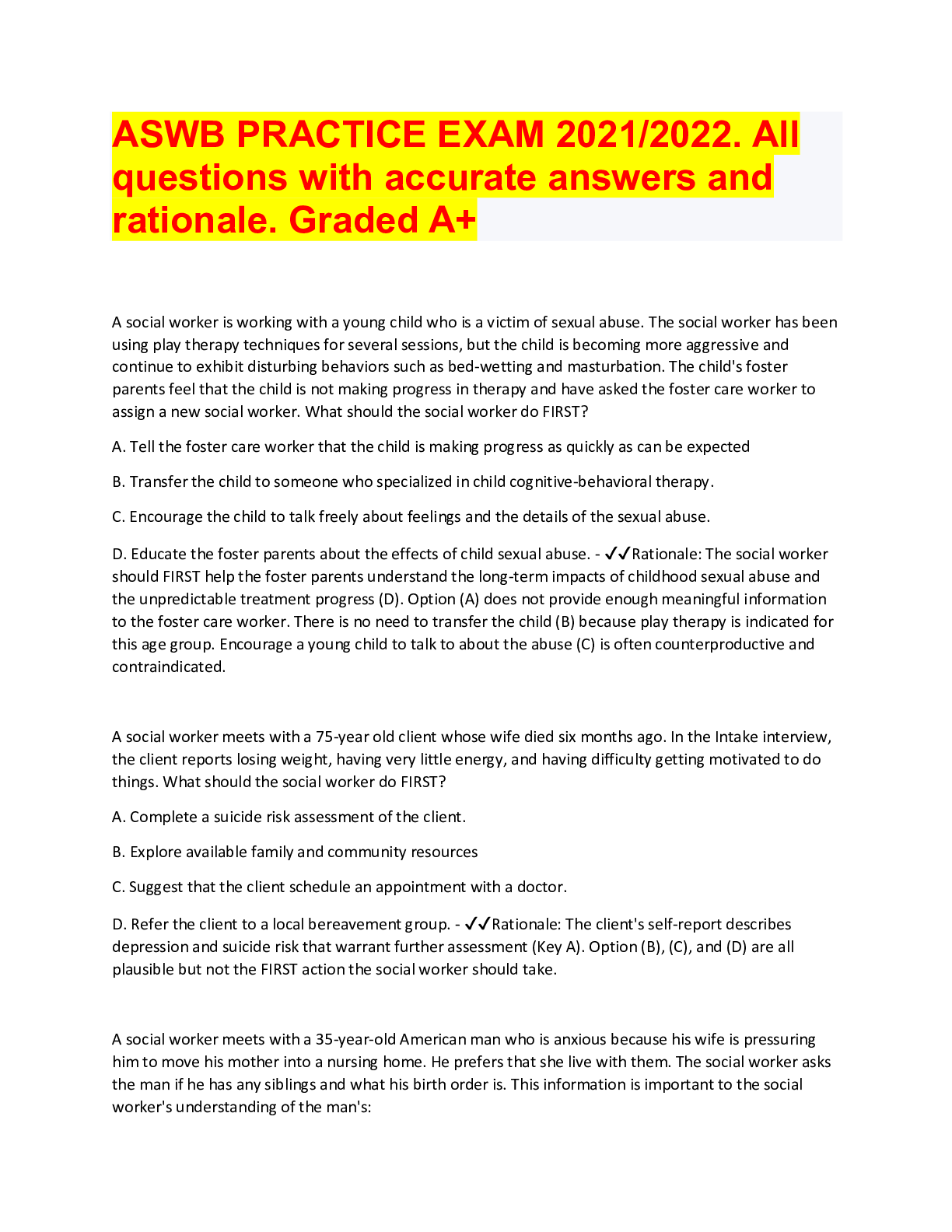
Also available in bundle (1)
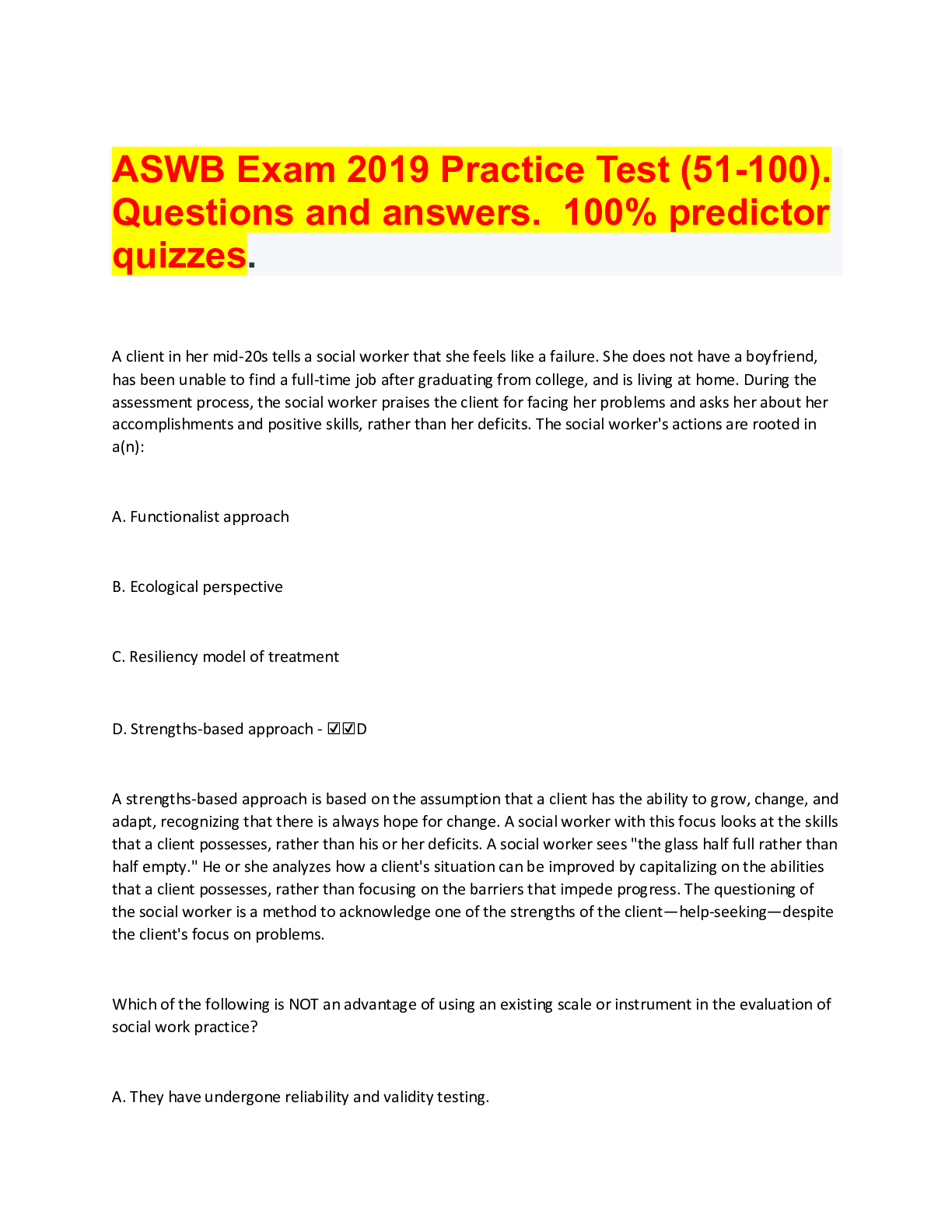
ASWB EXAMS bundle,
Questions with accurate answers. Predictor questions and answers
By bundleHub Solution guider 1 year ago
$40
12
Reviews( 0 )
Document information
Connected school, study & course
About the document
Uploaded On
Aug 15, 2022
Number of pages
32
Written in
Additional information
This document has been written for:
Uploaded
Aug 15, 2022
Downloads
0
Views
83



